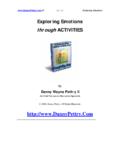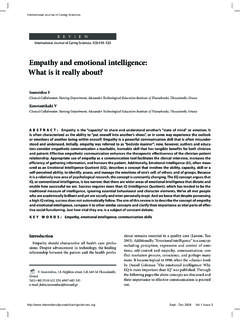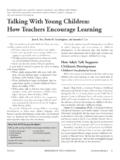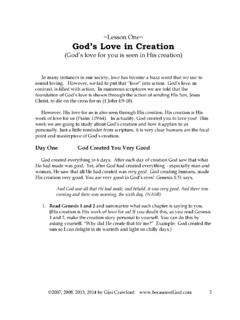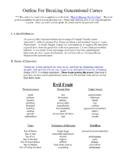Transcription of Twitter as a Corpus for Sentiment Analysis and …
1 Twitter as a Corpus for Sentiment Analysis and Opinion Mining Alexander Pak, Patrick Paroubek Universit e de Paris-Sud, Laboratoire LIMSI-CNRS, B atiment 508, F-91405 Orsay Cedex, France Abstract Microblogging today has become a very popular communication tool among Internet users. Millions of users share opinions on different aspects of life everyday. Therefore microblogging web-sites are rich sources of data for opinion mining and Sentiment Analysis . Because microblogging has appeared relatively recently, there are a few research works that were devoted to this topic. In our paper, we focus on using Twitter , the most popular microblogging platform, for the task of Sentiment Analysis . We show how to automatically collect a Corpus for Sentiment Analysis and opinion mining purposes.
2 We perform linguistic Analysis of the collected Corpus and explain discovered phenomena. Using the Corpus , we build a Sentiment classifier, that is able to determine positive, negative and neutral sentiments for a document. Experimental evaluations show that our proposed techniques are efficient and performs better than previously proposed methods. In our research, we worked with English, however, the proposed technique can be used with any other language. 1. Introduction can be obtained from microblogging services, as their users Microblogging today has become a very popular commu- post everyday what they like/dislike, and their opinions on nication tool among Internet users. Millions of messages many aspects of their life. are appearing daily in popular web-sites that provide ser- In our paper, we study how microblogging can be used for vices for microblogging such as Twitter1 , Tumblr2, Face- Sentiment Analysis purposes.
3 We show how to use Twit- book3. Authors of those messages write about their life, ter as a Corpus for Sentiment Analysis and opinion mining. share opinions on variety of topics and discuss current is- We use microblogging and more particularly Twitter for the sues. Because of a free format of messages and an easy ac- following reasons: cessibility of microblogging platforms, Internet users tend Microblogging platforms are used by different people to shift from traditional communication tools (such as tra- to express their opinion about different topics, thus it ditional blogs or mailing lists) to microblogging services. is a valuable source of people's opinions. As more and more users post about products and services they use, or express their political and religious views, mi- Twitter contains an enormous number of text posts and croblogging web-sites become valuable sources of people's it grows every day.
4 The collected Corpus can be arbi- opinions and sentiments. Such data can be efficiently used trarily large. for marketing or social studies. Twitter 's audience varies from regular users to celebri- We use a dataset formed of collected messages from Twit- ties, company representatives, politicians4 , and even ter. Twitter contains a very large number of very short mes- country presidents. Therefore, it is possible to collect sages created by the users of this microblogging platform. text posts of users from different social and interests The contents of the messages vary from personal thoughts groups. to public statements. Table 1 shows examples of typical posts from Twitter . Twitter 's audience is represented by users from many As the audience of microblogging platforms and services countries5.
5 Although users from are prevailing, it grows everyday, data from these sources can be used in is possible to collect data in different languages. opinion mining and Sentiment Analysis tasks. For example, manufacturing companies may be interested in the follow- We collected a Corpus of 300000 text posts from Twitter ing questions: evenly split automatically between three sets of texts: What do people think about our product (service, com- 1. texts containing positive emotions, such as happiness, pany etc.)? amusement or joy How positive (or negative) are people about our prod- 2. texts containing negative emotions, such as sadness, uct? anger or disappointment What would people prefer our product to be like? 3. objective texts that only state a fact or do not express any emotions Political parties may be interested to know if people sup- port their program or not.
6 Social organizations may ask We perform a linguistic Analysis of our Corpus and we show people's opinion on current debates. All this information how to build a Sentiment classifier that uses the collected Corpus as training data. 1. 2 4. 3 5. #countries 1320. funkeybrewster: @redeyechicago I think Obama's visit might've sealed the victory for Chicago. Hopefully the games mean good things for the city. vcurve: I like how Google celebrates little things like this: honors Con- fucius Birthday Japan Probe mattfellows: Hai world. I hate faulty hardware on remote systems where politics prevents you from moving software to less faulty systems. brroooklyn: I love the sound my iPod makes when I shake to shuffle it. Boo bee boo MeganWilloughby: Such a Disney buff.
7 Just found out about the new Alice in Won- derland movie. Official trailer: I love the Cheshire Cat. Table 1: Examples of Twitter posts with expressed users' opinions Contributions J. Read in (Read, 2005) used emoticons such as :-) and :- The contributions of our paper are as follows: ( to form a training set for the Sentiment classification. For this purpose, the author collected texts containing emoti- 1. We present a method to collect a Corpus with posi- cons from Usenet newsgroups. The dataset was divided tive and negative sentiments, and a Corpus of objective into positive (texts with happy emoticons) and negative . texts. Our method allows to collect negative and pos- (texts with sad or angry emoticons) samples. Emoticons- itive sentiments such that no human effort is needed trained classifiers: SVM and Na ve Bayes, were able to ob- for classifying the documents.
8 Objective texts are also tain up to 70% of an accuracy on the test set. collected automatically. The size of the collected cor- In (Go et al., 2009), authors used Twitter to collect train- pora can be arbitrarily large. ing data and then to perform a Sentiment search. The ap- 2. We perform statistical linguistic Analysis of the col- proach is similar to (Read, 2005). The authors construct lected Corpus . corpora by using emoticons to obtain positive and neg- ative samples, and then use various classifiers. The best 3. We use the collected corpora to build a Sentiment clas- result was obtained by the Na ve Bayes classifier with a sification system for microblogging. mutual information measure for feature selection. The au- 4. We conduct experimental evaluations on a set of real thors were able to obtain up to 81% of accuracy on their microblogging posts to prove that our presented tech- test set.
9 However, the method showed a bad performance nique is efficient and performs better than previously with three classes ( negative , positive and neutral ). proposed methods. Organizations 3. Corpus collection The rest of the paper is organized as follows. In Section 2, Using Twitter API we collected a Corpus of text posts and we discuss prior works on opinion mining and Sentiment formed a dataset of three classes: positive sentiments, nega- Analysis and their application for blogging and microblog- tive sentiments, and a set of objective texts (no sentiments). ging. In Section 3, we describe the process of collecting the To collect negative and positive sentiments, we followed corpora. We describe the linguistic Analysis of the obtained the same procedure as in (Read, 2005; Go et al.)
10 , 2009). We Corpus in Section 4 and show how to train a Sentiment clas- queried Twitter for two types of emoticons: sifier and our experimental evaluations in Section 5. Fi- nally, we conclude about our work in Section 6. Happy emoticons: :-) , :) , =) , :D etc. 2. Related work Sad emoticons: :-( , :( , =( , ;( etc. With the population of blogs and social networks, opinion mining and Sentiment Analysis became a field of interest The two types of collected corpora will be used to train a for many researches. A very broad overview of the ex- classifier to recognize positive and negative sentiments. isting work was presented in (Pang and Lee, 2008). In In order to collect a Corpus of objective posts, we retrieved their survey, the authors describe existing techniques and text messages from Twitter accounts of popular newspapers approaches for an opinion-oriented information retrieval.
